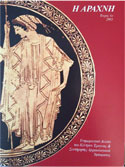Written sources
Written sources offer a broad spectrum of information about ancient Greek textiles. Depending on their nature, texts and inscriptions provide information about the use and, rarely, the processing of raw textile materials, about the function of textile tools such as spindle-whorls and loom-weights and about colours and patterns of fabrics. They also mention numerous textile characteristics, such as decorative patterns and techniques and also embellishment treatments.
Classical written sources can be divided roughly into literary texts, specific technical handbooks and administrative documents. Plato makes extensive use of weaving and spinning scenes as metaphors in order to explain his topic, whereas historians as Herodotus and Xenophon often provide information about garment types and decorations. The philosopher Theophrastus offers valuable insights to the dyestuffs used for textile dyes. In the plays of Aristophanes, on the other hand, we can find information about textile production and commerce. Several other written sources about theatre, political or judicial speeches, poetry, philosophy, and history complete our information.
Inscriptions constitute another crucial corpus of information about textile production and technology. They are particularly important for the study of social organisation, providing, on the one hand, numerous terms of textile-related occupations and on the other, information on the exchange and trade of raw materials and finished products. The 4th c. BC votive inscription of textiles and garments to Artemis Brauronia in particular offers information about raw materials, types of garments, colours and various decorative techniques.
However, the polysemy of Greek language regarding technical terminology and the evolution of meanings through time are obstacles to the interpretation of many terms and the modern reader has to treat them with caution in order to avoid misunderstandings.


